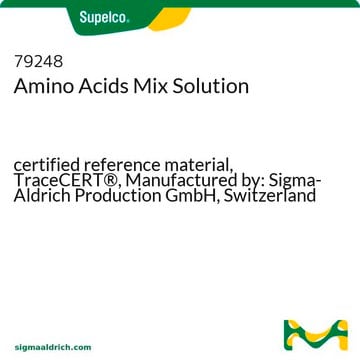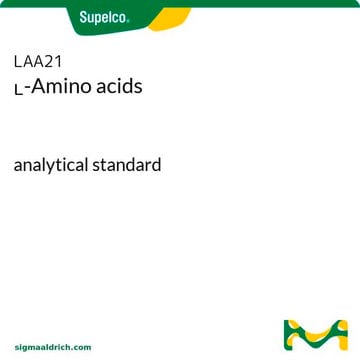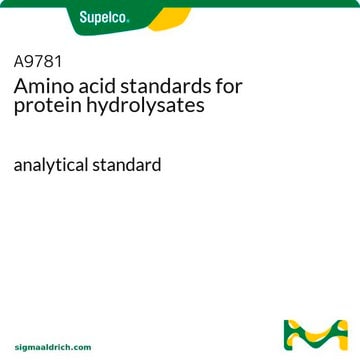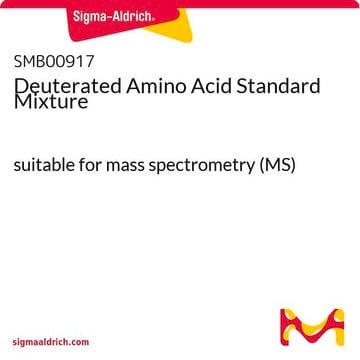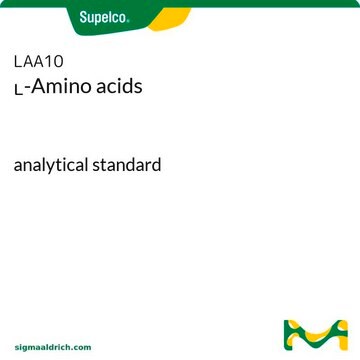This standard can be derivatized using MSFTA and subsequently used for GCMS analysis.
推薦產品
等級
analytical standard
儲存期限
limited shelf life, expiry date on the label
分析物化學類別
amino acids, peptides, proteins
技術
HPLC: suitable
gas chromatography (GC): suitable
應用
food and beverages
形式
multi-component solution
儲存溫度
2-8°C
應用
- 手性Marfeys试剂衍生后通过液相色谱-串联质谱(LC-MS/MS)测定L-和D氨基酸及甘氨酸
- 采用高效液相色谱法(HPLC)对脱脂米糠(DRB)浓缩蛋白进行氨基酸分析,评价其铁结合能力
- 开发气相色谱-质谱(GC-MS)方法,利用1,1,1,2,2,3,3-七氟氯甲酸丁酯进行衍生化和液-液微萃取样品处理,分析人类尿液样本中的112种氨基羧基代谢物
- 采用高效液相色谱法结合C18柱荧光检测,对天然水样中各种形式—的游离、溶解、颗粒和总氨基酸进行非对映体检测和定量
包裝
成分
- L-丙氨酸
- 氯化铵
- L-精氨酸
- L-天冬氨酸
- L-胱氨酸
- L-谷氨酸
- 甘氨酸
- L-组氨酸
- L-异亮氨酸
- L-亮氨酸
- L-赖氨酸
- L-蛋氨酸
- L-苯丙氨酸
- L-脯氨酸
- L-丝氨酸
- L-苏氨酸
- L-酪氨酸
- L-缬氨酸
其他說明
相關產品
訊號詞
Warning
危險聲明
防範說明
危險分類
Met. Corr. 1
儲存類別代碼
8B - Non-combustible corrosive hazardous materials
水污染物質分類(WGK)
nwg
閃點(°F)
Not applicable
閃點(°C)
Not applicable
從最近期的版本中選擇一個:
分析證明 (COA)
-
Can this Amino acid standard be used for GCMS analysis? And can it be subjected to MSFTA derivitisation?
1 answer-
Helpful?
-
-
What is the suggested procedure to hydrolyse cystine? Does the hydrolysis procedure affect other amino acids?
1 answer-
This product is intended to be used as an analytical standard and is not suitable for chemical processing. Please contact your regional technical service group for assistance with suitable reagents for your application.
Helpful?
-
-
Is there a recommended HPLC method and associated chromatogram to allow identification of each of the peaks and quantification of each amino acid in a sample (by retention time/integration)?
1 answer-
No method is available to identify each of the peaks for this product. Contact the regional Technical Service group for assistance with identifying chromatographic peaks according to specific analytical techniques.
Helpful?
-
-
How is shipping temperature determined? And how is it related to the product storage temperature?
1 answer-
Products may be shipped at a different temperature than the recommended long-term storage temperature. If the product quality is sensitive to short-term exposure to conditions other than the recommended long-term storage, it will be shipped on wet or dry-ice. If the product quality is NOT affected by short-term exposure to conditions other than the recommended long-term storage, it will be shipped at ambient temperature. As shipping routes are configured for minimum transit times, shipping at ambient temperature helps control shipping costs for our customers. For more information, please refer to the Storage and Transport Conditions document: https://www.sigmaaldrich.com/deepweb/assets/sigmaaldrich/marketing/global/documents/316/622/storage-transport-conditions-mk.pdf
Helpful?
-
-
How can I determine the shelf life / expiration / retest date of this product?
1 answer-
If this product has an expiration or retest date, it will be shown on the Certificate of Analysis (COA, CofA). If there is no retest or expiration date listed on the product's COA, we do not have suitable stability data to determine a shelf life. For these products, the only date on the COA will be the release date; a retest, expiration, or use-by-date will not be displayed.
For all products, we recommend handling per defined conditions as printed in our product literature and website product descriptions. We recommend that products should be routinely inspected by customers to ensure they perform as expected.
For products without retest or expiration dates, our standard warranty of 1 year from the date of shipment is applicable.
For more information, please refer to the Product Dating Information document: https://www.sigmaaldrich.com/deepweb/assets/sigmaaldrich/marketing/global/documents/449/386/product-dating-information-mk.pdfHelpful?
-
-
What is the difference between AAS18 and 79248 (CRM)? What are the storage and shipping conditions? How does the quality of AAS18 compare to CRM?
1 answer-
AAS18 is stored at 2-8°C, while 79248 is stored at -20°C. Both are shipped at ambient temperature. Amino Acid 79248 is a CRM, Certified Reference Material, and AAS18 is a standard. AAS18 does not undergo the rigorous testing that is used for CRM standards.
Helpful?
-
-
Wie lange ist der AAS18 Aminosäuren Standard haltbar, wenn er bei Temperaturen von 2-8°C gelagert wird?
1 answer-
The expiration date of this product is listed on the lot-specific Certificate of Analysis.
Please access the link below to download a Certificate:
https://www.sigmaaldrich.com/product/sial/aas18#product-documentationHelpful?
-
Active Filters
我們的科學家團隊在所有研究領域都有豐富的經驗,包括生命科學、材料科學、化學合成、色譜、分析等.
聯絡技術服務